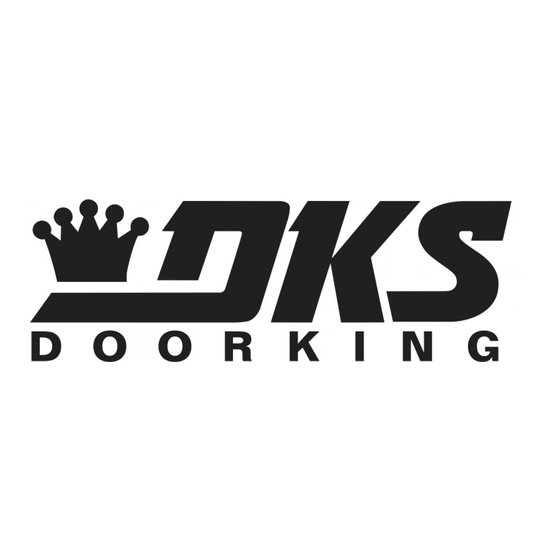
Advertisement
Quick Links
MODEL 8059 MicroCLIK
The model 8059 RF Receiver is designed for use as a Stand-Alone or Wiegand applications using MicroCLIK™ transmitters. Stand-Alone installa-
tions can store up to 80 transmitter codes in its memory. It is also programmed to recognize only certain MicroCLIK™ transmitter buttons when
using multiple button transmitters.
The 8059 receiver activates a built-in dry contact form "C" relay
when a programmed MicroCLIK™ transmitter code is received.
The received code MUST match the programmed "Transmitter
Code", "Facility Code" (or not match the Facility Code if a
Wiegand controller is used), and "Transmitter Button Code"
before the receiver relay will activate.
Wiegand applications will output transmitter codes in 26-bit or 31-bit Wiegand format to an external Wiegand controller.
The MicroCLIK™ system is compatible with the HomeLink system found in many automobiles.
Installation
This receiver is NOT designed to be installed outdoors without being protected
from the weather. An outdoor enclosure is available for the receiver if required
(P/N 8057-110 - Metal Outdoor Box).
Install the 8059 receiver in a location so the antenna is NOT surrounded by
metal and is in free air as high as possible above the ground. A longer Coax
Antenna kit is available for the receiver if required (P/N 1514-073 - Includes
antenna, mounting "L" bracket and 15 feet of coax cable). An antenna amplifier
kit (P/N 8058-080) or a Yagi directional antenna kit (P/N 1514-072) is also
available for the receiver if required.
The Programming LED on the side of the case will blink as RF energy is
received. If the programming LED blinks or is on continuously, this
indicates that there may be interference on the frequency (318 MHz) and
short range may be the result. If this happens, try relocating the receiver
or remove the source of interference. An antenna amplifier or a
directional antenna may be needed. Note: Loop detectors and proximity
card readers can cause receiver interference.
Receiver Terminal Wiring
Stand-Alone Power and Device Wiring :
terminals #1 and #2. Use minimum 18 AWG wire to power the receiver.
• If DC power is used (Transformer): Terminal #1 is NEGATIVE and Terminal #2 is POSITIVE.
12-24 Volt
• Connect the receiver relay contacts to the device to be activated.
Transformer
- Receiver Terminal #3 is the relay contact Normally OPEN (N.O.)
- Receiver Terminal #4 is the relay contact Normally CLOSED (N.C.)
- Receiver Terminal #5 is the relay contact Common (C).
To Receiver Terminal #1 (Neg.)
To Receiver Terminal #2 (Pos.)
Wiegand Controller Wiring:
Receiver terminal #2 is INPUT POWER (12-24 V).
Receiver terminal #6 is Wiegand input power COMMON.
Receiver terminal #7 is Wiegand DATA 0.
Receiver terminal #8 is Wiegand DATA 1.
Use 22 AWG shielded wire, maximum
200 feet, for Wiegand controller wiring.
Connect these terminals to the
corresponding terminals on
the Wiegand controller. Refer to the
DoorKing Wiegand controller installa-
tion manual 1835, 1837 or 1838 for
specific wiring information.
DC Polarity Matters!
™
RF RECEIVER (WIEGAND)
P/N 8066-080
Be sure the antenna, coax shield
and F connector are completely
isolated from the ground.
Removable
receiver terminal
for easy wiring.
#1 - Input Power Common
#2 - Input Power
#3 - Relay Contact (Normally Open)
#4 - Relay Contact (Normally Closed)
#5 - Relay Contact (Common)
#6 - Wiegand Common
#7 - Wiegand Data 0
#8 - Wiegand Data 1
Connect 12 - 24 Volt AC or DC power to
Stand-Alone Gate Operator:
wires from the gate operator as indicated. Refer
to the chosen gate operator's installation/owner's
manual for specific wiring information.
From "Low Voltage Common"
From "Circuit Board" Power
From "Radio Open"
From "Circuit Board" Power
From "Low Voltage Common"
From "Data 0"
From "Data 1"
P/N 8067-080
MicroCLIK™ Transmitters
R e
c e i
T e r
v e r
m i
n a
l
(Negative)
12-24 Volt AC, 12-24 Volt DC (Positive)
To Receiver Terminal #1
To Receiver Terminal #2
To Receiver Terminal #3
To Receiver Terminal #2
To Receiver Terminal #6
To Receiver Terminal #7
To Receiver Terminal #8
Inglewood, California 90301
DoorKing Part Number
8059-080
80 Transmitter Codes
P/N 8068-080
t o r
n e c
o n
F C
D
L E
i n g
m m
18"
g r a
P r o
Coax
Cable
Terminals 3-4-5
rated for 30 volt,
1 amp max.
Coax
Antenna
Kit
(Included)
Connect the 3
120 Glasgow Avenue
U.S.A.
Advertisement

Subscribe to Our Youtube Channel
Summary of Contents for DoorKing MicroCLICK 8059
- Page 1 To Receiver Terminal #7 corresponding terminals on From “Data 1” To Receiver Terminal #8 the Wiegand controller. Refer to the DoorKing Wiegand controller installa- tion manual 1835, 1837 or 1838 for 120 Glasgow Avenue specific wiring information. Inglewood, California 90301...
- Page 2 How Receiver Functions The 8059 receiver responds to the MicroCLIK™ transmitter code is defined by “Facility Codes” and “Transmitter Button Codes”. For example: an 8059 receiver can be programmed to respond to only the first button on a multiple button MicroCLIK™ transmitter while a second 8059 receiver can be programmed to respond to only the second button of t t o the same multiple button MicroCLIK™...
- Page 3 (approx. 10 seconds idle time). These 3 codes must match the master transmitter’s 3 codes in order to put the receiver automatically back into the “Learn Mode” when adding additional transmitters in the future. 120 Glasgow Avenue Copyright 2012 DoorKing, Inc. All rights reserved. Inglewood, California 90301 U.S.A.



Need help?
Do you have a question about the MicroCLICK 8059 and is the answer not in the manual?
Questions and answers